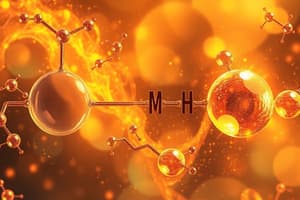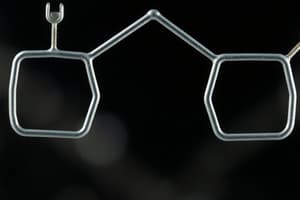Podcast
Questions and Answers
Which compound is an example of a ketone?
Which compound is an example of a ketone?
What distinguishes aldehydes from other carbonyl compounds?
What distinguishes aldehydes from other carbonyl compounds?
What is characteristic of carboxylic acids?
What is characteristic of carboxylic acids?
Which process involves the reaction between a carboxylic acid and an alcohol?
Which process involves the reaction between a carboxylic acid and an alcohol?
Signup and view all the answers
What distinguishes ketones from aldehydes?
What distinguishes ketones from aldehydes?
Signup and view all the answers
What reductants are commonly used to convert carbonyl compounds into other functional groups?
What reductants are commonly used to convert carbonyl compounds into other functional groups?
Signup and view all the answers
Which transition metals are typically used for catalytic hydrogenation of carbonyl compounds?
Which transition metals are typically used for catalytic hydrogenation of carbonyl compounds?
Signup and view all the answers
What is the product when acetophenone ( ext{PhCOCH₃}) is reduced?
What is the product when acetophenone ( ext{PhCOCH₃}) is reduced?
Signup and view all the answers
What happens to the oxidation state of a carbonyl compound when it undergoes reduction?
What happens to the oxidation state of a carbonyl compound when it undergoes reduction?
Signup and view all the answers
What type of reactions do carbonyl compounds undergo at the carbonyl carbon center?
What type of reactions do carbonyl compounds undergo at the carbonyl carbon center?
Signup and view all the answers
Why is understanding aldehydes, ketones, and carboxylic acids essential in organic chemistry?
Why is understanding aldehydes, ketones, and carboxylic acids essential in organic chemistry?
Signup and view all the answers
Study Notes
Carbonyl Compounds: Aldehydes, Ketones, Carboxylic Acids, Esterification, Reduction
Carbonyl groups ((-)C=O), found in various organic molecules, play a pivotal role in chemistry due to their unique reactivity patterns. This article will explore four important classes of carbonyl compounds — aldehydes, ketones, carboxylic acids, and their derivatives like esters—as well as the reduction of these compounds to better understand their properties.
Aldehydes bear one carbonyl group attached to an aliphatic (having only carbon and hydrogen atoms) or aromatic hydroxyl group ((\text{RCHO})), making them the simplest types of carbonyl compounds. Examples include formaldehyde ((\text{HCHO})) and acetaldehyde ((\text{CH₃\ CHCHO})). Ketones have two carbons connected by a double bond with an oxygen atom as part of the functional group ((\text{RCOR'})), featuring structures such as acetone ((\text{CH₃COCH₃})) and cyclohexanone ((\text{C₆H₁₁COCH₃})). In comparison, carboxylic acids possess a carbonyl group next to either an alcohol ((\text{-OH})) or acidic hydrogen ((\text{-COOH})); common examples are formic acid ((\text{HCOOH})) and acetic acid ((\text{CH₃COOH})).
Esterification is the reaction between a carboxylic acid and an alcohol to produce esters, which carry out a diverse range of chemical functions. An example would be ethanoic acid and methanol forming ethyl acetate ((\text{CH₃COOC₂H₅})).
The reduction of carbonyl compounds involves converting the (-\text{C=O}) group into other functional groups through reactions with reductants such as sodium borohydride (NaBH₄) or catalytic hydrogenation with a transition metal (typically nickel or palladium). For instance, reducing acetophenone ((\text{PhCOCH₃})), a ketone, yields phenylethanol ((\text{PhCH₂CH₂OH})). Similarly, the oxidation state of a carbonyl compound decreases upon being reduced.
Another notable feature of carbonyl compounds is their ability to undergo nucleophilic addition reactions at the carbonyl carbon center, resulting in the formation of new bonds with attacking species called nucleophiles. These reactions lead to the construction of more complex organic chemicals as building blocks, serving as a fundamental concept within synthetic organic chemistry.
In summary, understanding carbonyl compounds like aldehydes, ketones, and carboxylic acids helps us grasp essential concepts related to chemistry's fundamentals, while also providing insights into how they can participate in valuable industrial processes and applications.
Studying That Suits You
Use AI to generate personalized quizzes and flashcards to suit your learning preferences.
Description
Explore the fundamental characteristics of carbonyl compounds like aldehydes, ketones, and carboxylic acids, including their properties, structures, reactions, and applications. Learn about esterification, reduction processes, nucleophilic addition reactions, and the significance of these compounds in organic chemistry.





